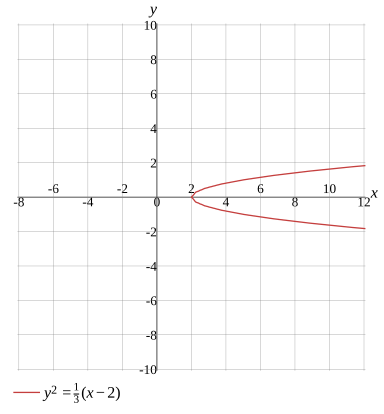Question
Identify the conic
Find the standard equation of the parabola
Find the vertex of the parabola
Find the focus of the parabola
Load more

y2=31(x−2)
Evaluate
x=3y2+2
Swap the sides of the equation
3y2+2=x
Move the constant to the right-hand side and change its sign
3y2=x−2
Multiply both sides of the equation by 31
3y2×31=(x−2)×31
Multiply the terms
More Steps


Evaluate
3y2×31
Multiply the numbers
More Steps


Evaluate
3×31
Reduce the numbers
1×1
Simplify
1
y2
y2=(x−2)×31
Multiply the terms
More Steps


Evaluate
(x−2)×31
Apply the distributive property
x×31−2×31
Use the commutative property to reorder the terms
31x−2×31
Multiply the numbers
31x−32
y2=31x−32
Solution
y2=31(x−2)
Show Solution

Solve the equation
y=33x−6y=−33x−6
Evaluate
x=3y2+2
Swap the sides of the equation
3y2+2=x
Move the constant to the right-hand side and change its sign
3y2=x−2
Divide both sides
33y2=3x−2
Divide the numbers
y2=3x−2
Take the root of both sides of the equation and remember to use both positive and negative roots
y=±3x−2
Simplify the expression
More Steps


Evaluate
3x−2
To take a root of a fraction,take the root of the numerator and denominator separately
3x−2
Multiply by the Conjugate
3×3x−2×3
Calculate
3x−2×3
Calculate
More Steps


Evaluate
x−2×3
The product of roots with the same index is equal to the root of the product
(x−2)×3
Calculate the product
3x−6
33x−6
y=±33x−6
Solution
y=33x−6y=−33x−6
Show Solution

Testing for symmetry
Testing for symmetry about the origin
Testing for symmetry about the x-axis
Testing for symmetry about the y-axis
Not symmetry with respect to the origin
Evaluate
x=3y2+2
To test if the graph of x=3y2+2 is symmetry with respect to the origin,substitute -x for x and -y for y
−x=3(−y)2+2
Evaluate
−x=3y2+2
Solution
Not symmetry with respect to the origin
Show Solution

Find the first derivative
Find the derivative with respect to x
Find the derivative with respect to y
dxdy=6y1
Calculate
x=3y2+2
Take the derivative of both sides
dxd(x)=dxd(3y2+2)
Use dxdxn=nxn−1 to find derivative
1=dxd(3y2+2)
Calculate the derivative
More Steps


Evaluate
dxd(3y2+2)
Use differentiation rules
dxd(3y2)+dxd(2)
Evaluate the derivative
More Steps


Evaluate
dxd(3y2)
Use differentiation rules
dyd(3y2)×dxdy
Evaluate the derivative
6ydxdy
6ydxdy+dxd(2)
Use dxd(c)=0 to find derivative
6ydxdy+0
Evaluate
6ydxdy
1=6ydxdy
Swap the sides of the equation
6ydxdy=1
Divide both sides
6y6ydxdy=6y1
Solution
dxdy=6y1
Show Solution

Find the second derivative
Find the second derivative with respect to x
Find the second derivative with respect to y
dx2d2y=−36y31
Calculate
x=3y2+2
Take the derivative of both sides
dxd(x)=dxd(3y2+2)
Use dxdxn=nxn−1 to find derivative
1=dxd(3y2+2)
Calculate the derivative
More Steps


Evaluate
dxd(3y2+2)
Use differentiation rules
dxd(3y2)+dxd(2)
Evaluate the derivative
More Steps


Evaluate
dxd(3y2)
Use differentiation rules
dyd(3y2)×dxdy
Evaluate the derivative
6ydxdy
6ydxdy+dxd(2)
Use dxd(c)=0 to find derivative
6ydxdy+0
Evaluate
6ydxdy
1=6ydxdy
Swap the sides of the equation
6ydxdy=1
Divide both sides
6y6ydxdy=6y1
Divide the numbers
dxdy=6y1
Take the derivative of both sides
dxd(dxdy)=dxd(6y1)
Calculate the derivative
dx2d2y=dxd(6y1)
Use differentiation rules
dx2d2y=61×dxd(y1)
Rewrite the expression in exponential form
dx2d2y=61×dxd(y−1)
Calculate the derivative
More Steps


Evaluate
dxd(y−1)
Use differentiation rules
dyd(y−1)×dxdy
Use dxdxn=nxn−1 to find derivative
−y−2dxdy
dx2d2y=61(−y−2dxdy)
Rewrite the expression
dx2d2y=61(−y2dxdy)
Calculate
dx2d2y=−6y2dxdy
Use equation dxdy=6y1 to substitute
dx2d2y=−6y26y1
Solution
More Steps


Calculate
−6y26y1
Divide the terms
More Steps


Evaluate
6y26y1
Multiply by the reciprocal
6y1×6y21
Multiply the terms
6y×6y21
Multiply the terms
36y31
−36y31
dx2d2y=−36y31
Show Solution

Rewrite the equation
r=6sin2(θ)cos(θ)−25cos2(θ)−24r=6sin2(θ)cos(θ)+25cos2(θ)−24
Evaluate
x=3y2+2
Move the expression to the left side
x−3y2=2
To convert the equation to polar coordinates,substitute rcos(θ) for x and rsin(θ) for y
cos(θ)×r−3(sin(θ)×r)2=2
Factor the expression
−3sin2(θ)×r2+cos(θ)×r=2
Subtract the terms
−3sin2(θ)×r2+cos(θ)×r−2=2−2
Evaluate
−3sin2(θ)×r2+cos(θ)×r−2=0
Solve using the quadratic formula
r=−6sin2(θ)−cos(θ)±cos2(θ)−4(−3sin2(θ))(−2)
Simplify
r=−6sin2(θ)−cos(θ)±25cos2(θ)−24
Separate the equation into 2 possible cases
r=−6sin2(θ)−cos(θ)+25cos2(θ)−24r=−6sin2(θ)−cos(θ)−25cos2(θ)−24
Use b−a=−ba=−ba to rewrite the fraction
r=6sin2(θ)cos(θ)−25cos2(θ)−24r=−6sin2(θ)−cos(θ)−25cos2(θ)−24
Solution
r=6sin2(θ)cos(θ)−25cos2(θ)−24r=6sin2(θ)cos(θ)+25cos2(θ)−24
Show Solution

Graph
